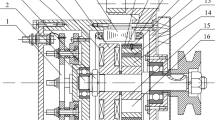Abstract
The switched reluctance motor (SRM) drives are emerging as an attractive solution for electric vehicle (EV) applications due to its favorable driving capacity. However, the inherent net radial force of SRM has an important effect on the vehicle ride comfort. This paper investigates the influences of net radial force induced by eccentric SRM with series/parallel circuits on vehicle ride comfort. The mechanical–electrical–magnetic coupling model of SRM is established by combing the numerical simulation and analytical method, in which the series and parallel circuits are structured, respectively. Then, quarter vibration vehicle models coupled with SRM are established. The net radial force of the two SRMs and ride comfort of the corresponding vehicles are simulated and discussed at different conditions. It is concluded that the SRM with parallel circuits generates smaller net radial forces, and the vehicle driven by SRM with parallel circuits will achieve better ride comfort due to the difference of branch currents.



















Similar content being viewed by others
Abbreviations
- \(c_{s} ,\;c_{t}\) :
-
Damping of suspension and tire
- \(F_{rk} ,\;F_{{rk{1}}} ,\;F_{{rk{2}}}\) :
-
Electromagnetic radial force of the k-phase
- \(F_{{r_{ - } z}}\) :
-
Component of net radial force in vertical direction
- \(F_{tx}\) :
-
Tangential reaction force of the road surface
- \(F_{tz}\) :
-
Normal force of the ground
- \(f_{r}\) :
-
Rolling resistance coefficient of tire
- I t :
-
Equivalent moment of inertia of wheel and body mass
- i, i k :
-
Winding current in k-phase
- \(k_{s} ,\;k_{t}\) :
-
Vertical stiffness of suspension and tire
- \(L,\;L_{k} ,\;L_{u} ,\;L_{a} ,\;L_{m}\) :
-
Winding inductance of k-phase
- l g :
-
Air gap between salient poles of the stator and rotor
- \(m_{s} ,\;m_{u}\) :
-
Sprung load mass and non-sprung load mass
- \(N_{r}\) :
-
Salient poles numbers of the rotor
- R e :
-
Radius of vehicle wheel
- R k :
-
Resistance of the k-phase winding
- \(T_{e} ,\;T_{k}\) :
-
Output motor torque and the k-phase torque
- U k :
-
Instantaneous voltage of k-phase winding
- \(W_{m} ^{\prime}\) :
-
Magnetic common energy
- \(z_{s} ,\;z_{u} ,z_{g}\) :
-
Vertical displacement of sprung load mass, non-sprung load mass and road surface
- \(\psi ,\;\psi_{k}\) :
-
Flux linkage of the k-phase
- \(\theta\) :
-
Rotor position angle
- \(\dot{\omega }\) :
-
Angular acceleration of wheel rotation
References
Xue XD, Cheng KWE, Lin JK, Zhang Z, Luk KF, Ng TW (2010) Optimal control method of motoring operation for SRM drives in electric vehicles. IEEE Trans Veh Technol 59:1191–1204
Timothy J, Miller E et al (1995) Faults and Unbalance Forces in the Switched Reluctance Machine. IEEE Trans Industry Appl 31(2):319–328
Hur J, Kang GH, Lee JY, Hong JP, Lee BK (2004) Design and optimization of high torque, low ripple switched reluctance motor with flux barrier for direct drive. In: Industry Applications Conference, Seattle, WA, USA.
Dadpour A, Ansari K, Divandari M, Hosseinkhah MR (2013) Conversion of Shaded-Pole Induction Motor to Switched Reluctance Motor and Effects of Pole Shoe and Notch on SRM Noise. In: IEEE XXXIII Intern Sci Conf Electron Nanotechn, pp 344–348.
Higuchi T, Suenaga K, Abe T (2010) Torque ripple reduction of novel segment type switched reluctance motor by increasing phase number. In: International conference on electrical machines & systems, IEEE, pp 2175–2180.
Ozoglu Y, Garip M, Mese E (2005) New pole tip shapes mitigating torque ripple in short pitched and fully pitched switched reluctance motors. Electric Power Syst Res 74(1):95–103
Li G, Ojeda J, Hlioui S, Hoang E, Lecrivain M, Gabsi M (2012) Modification in rotor pole geometry of mutually coupled switched reluctance machine for torque ripple mitigating. IEEE Trans Magn 48(6):2025–2034
Suhail N, Singh RK (2015) Analysis of variation in torque ripple in switch reluctance motor with design. In: International conference on power, Allahabad, India.
Li J, Song X, Cho Y (2008) Comparison of 12/8 and 6/4 switched reluctance motor: noise andvibration aspects. IEEE Trans Magn 44(11):4131–4134
Mademlis C, Kioskeridis I (2003) Performance optimization in switched reluctance motor drives with online commutation angle control. IEEE Trans Energy Conv 18(3):448–457
Hwu KI, Liad CM (2003) Intelligent tuning of commutation for maximum torque capability of a switched reluctance motor. IEEE Trans Energy Convers 18(1):113–120
Xue XD, Cheng KWE, Ng TW, Cheng NC (2010) Multi-objective optimization design of in-wheel switched reluctance motors in electric vehicles. IEEE Trans Ind Electron 57(9):2980–2987
Mohammad MN, Amir R, Hamidreza K et al (2017) Adaptive control of switched reluctance motor drives under variable torque applications. J Electr Eng Technol 12(1):131–144
Wei S, Li Y, Huang J, Nong Z (2015) Vibration effect and control of in-wheel switched reluctance motor for electric vehicle. J Sound Vib 338:105–120
Wang YY, Li PF, Ren GZ (2016) Electric vehicles with in-wheel switched reluctance motors: Coupling effects between road excitation and the unbalanced radial force. J Sound Vib 372:69–81
Shao XX, Naghdy F, Du HP, Qin YC (2019) Coupling effect between road excitation and an in-wheel switched reluctance motor on vehicle ride comfort and active suspension control. J Sound Vib 443:683–702
Zhu YY, Zhao CW, Zhang JX, Gong ZP (2020) Vibration control for electric vehicles with in-wheel switched reluctance motor drive system. IEEE Access 8:7205–7216
Li Z, Zheng L, Gao WY, Zhan ZF (2019) Electromechanical coupling mechanism and control strategy for in-wheel-motor-driven electric vehicles. IEEE Trans Ind Electron 66(6):4524–4533
Xu B, Xiang CL, Qin YC, Ding P, Dong MM (2018) Semi-active vibration control for in-wheel switched reluctance motor driven electric vehicle with dynamic vibration absorbing structures: concept and validation. IEEE Access 6:60274–60285
Liu C, Zhou Q, Tang C, Zhu XZ (2008) Influence of winding connection on vibration and acoustic noise of switched reluctance machine. J China Univ Min Technol 25(22):265–269
Chindurza I, Dorrell D G, Cossar, C (2004) Vibration analysis of a switched-reluctance machine with eccentric rotor. Power Electronics, Mach Dri, IET pp 481–486.
Lin J, Cheng KWE, Zhang Z, Xue X (2009) Experimental investigation of in-wheel switched reluctance motor driving system for future electric vehicles. In: International conference on power electronics systems & applications, Hong Kong, China.
Wong KF, Cheng KWE, Ho SL (2007) Simulation of switched reluctance motor based on a combination of circuit-oriented and signal-oriented approaches using matlab/simpower systems. Electr Mach Power Syst 35(2):205–219
Husain I, Ehsani M (1996) Torque ripple minimization in switched reluctance motor drives by pwm current control. IEEE Trans Power Electron 11(1):83–88
Fahimi B, Suresh G, Mahdavi J, Ehsami M (1998) A new approach to model switched reluctance motor drive application to dynamic performance prediction, control and design. PESC 98 Record. In: 29th Annual IEEE power electronics specialists conference, Fukuoka, Japan.
Li Y, Sun W, Huang J et al (2013) Effect of vertical and lateral coupling between tire and road on vehicle rollover. Veh Syst Dyn 51(8):1216–1241
Cameron DE, Lang JH, Umans SD (1989) The origin of acoustic noise in variable-reluctance motors. Industry Applications Society Annual Meeting, San Diego
Ayari S, Besbes M, Lecrivain M, Gabsi M (1999) Effects of the air gap eccentricity on the SRM vibrations. In: IEEE international electric machines and drives conference, Seattle, WA, USA.
Acknowledgements
This research is supported by Shanghai Sailing Program (grant no.18YF1418500).
Author information
Authors and Affiliations
Corresponding author
Additional information
Technical Editor: Wallace Moreira Bessa.
Publisher's Note
Springer Nature remains neutral with regard to jurisdictional claims in published maps and institutional affiliations.
Rights and permissions
About this article
Cite this article
Zhang, D., Qi, T., Wang, S. et al. Effect of series/parallel circuits of eccentric switched reluctance motor on vehicle ride comfort. J Braz. Soc. Mech. Sci. Eng. 43, 232 (2021). https://doi.org/10.1007/s40430-021-02960-3
Received:
Accepted:
Published:
DOI: https://doi.org/10.1007/s40430-021-02960-3




